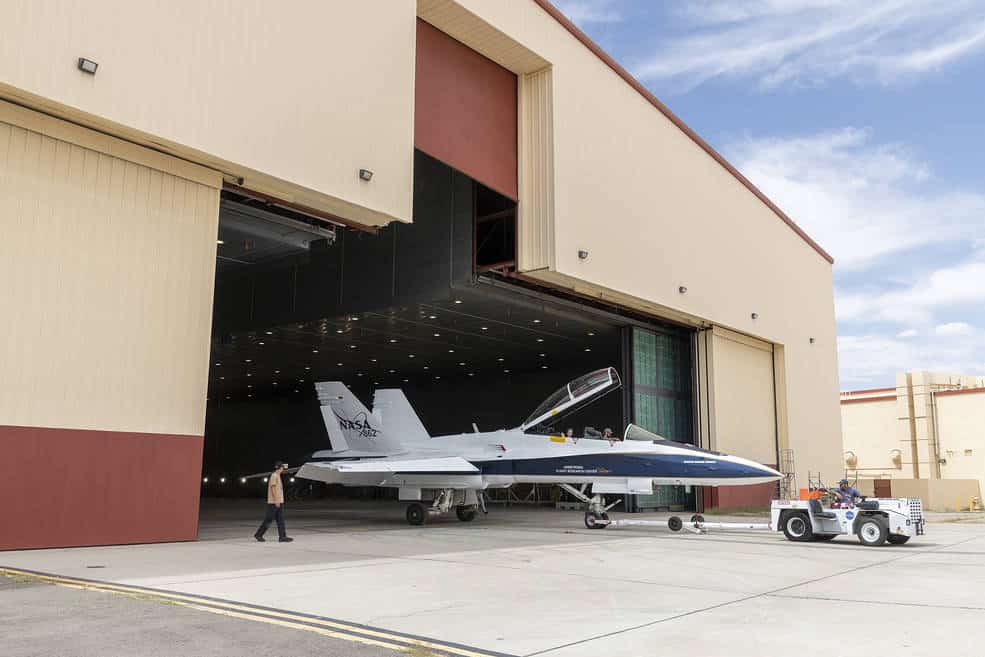Aerospace
F/A-18 Hornet Joins NASA-Owned F-15 to Chase After the X-59 Supersonic Aircraft

A F/A-18 aircraft that NASA purchased from the U.S. Navy in 2021 has undergone a thorough reconstruction according to NASA. In order to follow or “chase” the supersonic X-59 aircraft, this rejuvenated aircraft will join the Armstrong Flight Research Center’s fleet.
NASA is presently building the supersonic X-59 QueSST aircraft to show its dedication to cutting-edge aeronautical research. The installation of an engine in the X-59 marked an important project milestone in November 2022.
Additionally, it was revealed in January 2023 that the X-59’s first flight is planned to take place by the end of 2023, representing a significant advancement in NASA’s quest for supersonic flight capabilities.
NASA first stated it would make use of an F-15 in 2021. This aircraft will track the X-59 as it travels at supersonic speeds in an effort to measure and display the sound waves it generates. The F-15, run by NASA, has a gadget on its nose that allows it to maintain a close enough distance for that to occur. The Airborne Location Integrating Geospatial Navigation System (ALIGNS) was created to make it possible for the fighter plane’s pilot to coordinate maneuvers while flying behind the target at supersonic speeds.
It turns out that the F-15 is not sufficient for data collection on its alone. Both the Eagle and the Super Hornet will pursue the X-59. NASA will use the F/A-18D as a platform for photographers and videographers who will attempt to capture supersonic flight.
The aircraft underwent an overhaul procedure required after a certain amount of flight hours in order to participate in NASA Armstrong missions. This included removing the wings, inspecting for corrosion, modernizing systems, and performing other critical checks and service.

Aerospace
Boeing Transfers Rocket Stage to NASA, Paving Way for Human Moon Mission

Boeing has achieved a significant milestone by providing NASA with the second core stage of the Space Launch System (SLS) rocket.
This crucial component, crafted at NASA’s Michoud Assembly Facility (MAF), is set to propel the Artemis II crew into lunar orbit, marking humanity’s return to deep space after a 50-year hiatus.
The monumental Boeing-built rocket stage, the largest element of the Artemis II mission, will embark on a journey aboard the Pegasus barge, traveling 900 miles to NASA’s Kennedy Space Center.
Comparison of two legendary aircraft B777x vs B747 aircraft:Click here
Upon arrival, it will be meticulously integrated with other essential Artemis II components, including the upper stage, solid rocket boosters, and NASA’s Orion spacecraft within the iconic Vehicle Assembly Building. This intricate integration process is a vital step toward the eagerly anticipated Artemis II launch, slated for 2025.
“Boeing-built products helped land humankind on the moon in 1969, and we’re proud to continue that legacy through the Artemis generation,” remarked Dave Dutcher, vice president and program manager for Boeing’s SLS program. “Together, with NASA and our industry partners and suppliers, we are building the world’s most capable rocket and paving the way to deep space through America’s rocket factory in New Orleans.”
NASA, Lockheed Martin Reveal X-59 Quiet Supersonic Aircraft:Click here
The delivery of Core Stage 2 marks a significant achievement in the evolution of the SLS rocket. Towering over 200 feet and powered by four RS-25 engines, this core stage, coupled with two solid-fueled booster rockets, will generate a staggering 8.8 million pounds of thrust. This immense power is crucial to launching Artemis II and future missions into the vast expanse of space.
The SLS rocket stands unparalleled in its capability to transport both crew and substantial cargo to the moon and beyond in a single launch. Its extraordinary capacity will facilitate the delivery of human-rated spacecraft, habitats, and scientific missions to destinations including the moon and Mars, ushering in a new era of space exploration.
-

 Travel1 week ago
Travel1 week agoAir India to Expand US Operations with Three New Routes After a Decade
-

 Travel2 weeks ago
Travel2 weeks agoWhy We Should Avoid These Stamps in a Passport
-

 Airlines1 month ago
Airlines1 month agoInvestigations Reveal Fake Chinese Titanium in Boeing and Airbus Jets
-

 Tech4 weeks ago
Tech4 weeks agoChina’s CATL Plans 1,800-Mile Electric Plane Launch by 2027
-

 Airport3 days ago
Airport3 days agoTop 10 Largest Airports in the World by Size
-

 Aerospace4 weeks ago
Aerospace4 weeks agoChina’s Fighter Jets Turn Wings into Autonomous Drones
-

 Airlines4 days ago
Airlines4 days agoAir India Rolls Out A350s for Delhi-New York JFK and Newark Routes
-

 Defence3 weeks ago
Defence3 weeks agoBoeing Enhances Chinook with New Engines and Block II Upgrades at $96 Million







